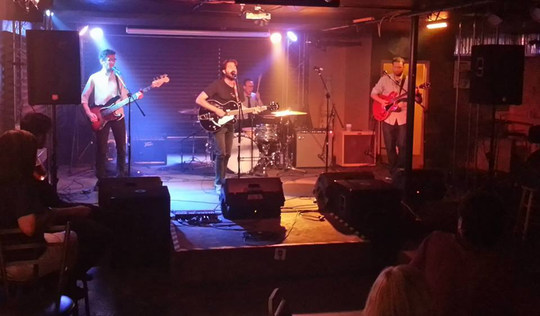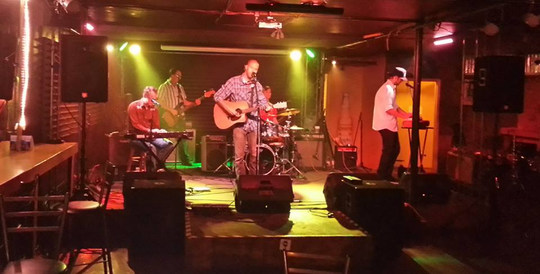“Everything having a proper place” and “making room for each other” are old-school techniques that never wear out.
Please Remember:
The opinions expressed are mine only. These opinions do not necessarily reflect anybody else’s opinions. I do not own, operate, manage, or represent any band, venue, or company that I talk about, unless explicitly noted.

 Nathan Spenser and The Low Keys
Nathan Spenser and The Low Keys
 Triggers & Slips
Triggers & Slips
I’m what might be termed as a “Nashville Poser.” I don’t actually have any real idea about what Nashville is like, or what it used to be like. All I have is this sort of romanticized notion about:
- Killer session players who stop by the studio for about half an hour, hammer out a perfect track in a take or two, and then run off to the next session.
- Studio engineers who can hear the motion of air molecules in the room, and patch preamps directly to a vintage tape machine because the million dollar console “doesn’t sound right.”
- A world that is generally populated by old pros who can do anything blindfolded, while comatose. Wearing gun-muffs. In another county.
I’m barely exaggerating those two latter points, by the way.
These perceptions of “that old-school Nashville professionalism” tend to stay with me because of one main reason – a reason that I’m not always aware of how fortunate I am to have:
People actually live out “that old-school Nashville professionalism” where I can see and hear it. Like this past Thursday.
Hey wait – aren’t you kinda against “old school?”
I’m going to talk about Thursday in a bit, but I should probably clear up some things first.
I have to admit, I can often come across as being against “old school.” I have this inordinate fondness for audio gear and tactics that push the boundaries. I’m one of the few people crazy enough to run a digital console (sane), in a live environment (also sane), on general-purpose computing hardware (totally nuts), without a control surface (kinda insane). I don’t care about tape. At all. Especially not analog, but also digital. (Sequential-access media? Really?) When someone says, “vintage analog,” what I actually hear is “heavy, hot, fragile, and generally impractical for live sound.”
I totally stole that last idea from Dave Rat, by the way.
This isn’t actually being “anti old-school,” though. It’s anti-“they did this stuff in the past and we should always keep doing it that way because everything sounded better in [insert decade where you fell in love with music].” I chafe very badly at doing things a certain way for only the reason that they’ve always been done that way. My hair stands on end when people come to the conclusion that going some route from decades past will magically solve all their problems. But…
I love, love, LOVE doings things in a certain way, a way that’s been around since shortly after the dinosaurs were hit by an asteroid, because that certain way is a bedrock technique that “the art” rests on. To me, that’s 100% legitimate – and actually, a no-brainer.
So…Thursday
This past Thursday, Nathan Spenser and The Low Keys put on an EP release party at Fats. The entire night was a display of how classic professionalism and “old-school techniques that actually work” are always, always, always in style.
The first band, Triggers & Slips, heavily used the classic technique of actually listening to each other while on stage. There was no “ball hogging” that I could hear, and even more importantly, when somebody took the lead, everybody else got out of the way.
This ability to know who has the musical spotlight, and to alter one’s volume, tone, and note choice to allow the current leader to actually be in front? That’s one of the numero uno hallmarks of a great, professional group of players.
Next up was The Low Keys. Along with listening to each other, they are a brilliant example of another technique used by old pros: Everything having its proper place.
You can actually tell this is the case before they start playing.
See, when the drummer (Bobby Clark) tells you, “I don’t need drums in the monitors. I just need the vocals, plus a bit of bass and Spenser’s guitar,” this is a good indicator of a volume war not being imminent. It’s a sign that the band’s sonics fit together into a nicely shaped whole, where the kit doesn’t have to be cranked in the fill for the drummer to have a hope of hearing what he’s doing with his own instrument.
(It can also be a sign that the drummer has just given up, and is going for whatever they think they can get to survive the gig, but that’s not the case with these guys.)
Also, I should definitely point out that asking for drums in the upstage fill because you like the way they sound in the upstage fill is totally legitimate – there’s a big difference between just wanting a bit of sweetening and having no choice but to out-shout someone else on stage.
Then, there’s the case of Mike Hunter’s bass. We didn’t have much of a soundcheck, because we were just putting things together on the fly. As such, a guess had to be made about where to put the bass amp’s level.
That guess was high – but here’s the beauty of bands where every instrument has its own space to live and breathe:
The bass wasn’t “too loud” in the usual sense. Because the bass wasn’t competing for the same space as the guitars and drums, a volume guess that was a bit high merely meant that the bass was “more pronounced than planned” instead of “way too !@#$ loud.” The mix at those first few moments still worked just fine. I just had to pull the bass fader back, and get on the gas with the guitars.
…and with everybody having their own space, and not being in a loudness competition, I could give the guitars a push without flattening the audience.
Then, the next bit of “old-school professionalism” came out. Actually, two bits. “Listening to each other” combined with that old standby, generosity. Even with me having pulled the bass back in the PA, Mike still felt like he was too far in front.
“Should I turn the bass amp down a little?” Mike asked.
“Yeah, I’m on the gas pretty hard with the guitars,” I said over the talkback.
So, the bass came down – and it didn’t get lost in the mix because (again, not to belabor the point), everything naturally had a spot in the mix.
Naturally.
As in, I didn’t have to manufacture the placement at FOH.
As I see it, another way of describing the old-school virtues of “listening to each other,” “everything having its own space,” and “generosity,” is this:
When they get on stage, they already sound like a band.
When you work with bands like The Low Keys and Triggers & Slips, you don’t have to do much. All that’s required is to take something that already sounds good, put it into the PA, allow the PA to do only as much sweetening as is necessary for that already good sound to translate well in the audience, and then…
…you stand back and enjoy the show.